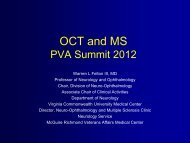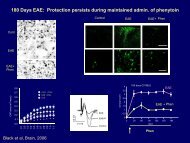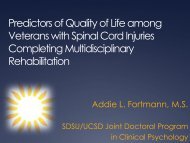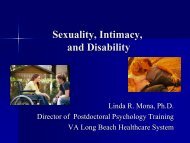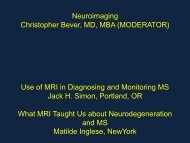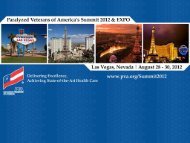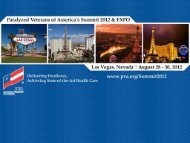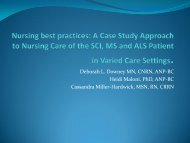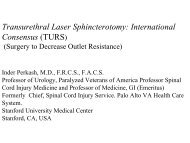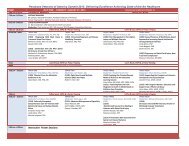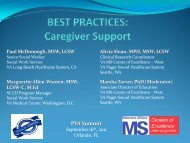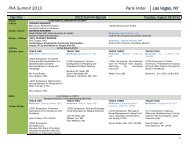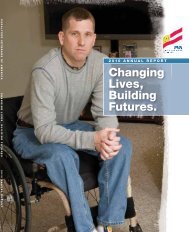Kristine L. Engel, RN, MSN, CRRN - Paralyzed Veterans of America
Kristine L. Engel, RN, MSN, CRRN - Paralyzed Veterans of America
Kristine L. Engel, RN, MSN, CRRN - Paralyzed Veterans of America
You also want an ePaper? Increase the reach of your titles
YUMPU automatically turns print PDFs into web optimized ePapers that Google loves.
A Transdisciplinary Education Model<br />
for Advancing Sexual Health in<br />
Adults with Spinal Cord Injury<br />
Presented by<br />
Michelle Wesline, <strong>RN</strong><br />
Kim Burie, MSW, APSW
Disclosures<br />
This continuing education activity is managed and accredited<br />
by Pr<strong>of</strong>essional Education Service Group. The material<br />
presented in this activity represents the opinion <strong>of</strong> the<br />
faculty. Neither PESG, nor any accrediting organization<br />
endorses any commercial products displayed in<br />
conjunction with this activity.<br />
Commercial Support was not received for this activity.<br />
Kim Burie, MSW, APSW and Michelle Wesline, <strong>RN</strong> have no<br />
financial interest or relationships to disclose.
Obtaining CME/CE Credit<br />
If you would like to receive continuing education<br />
credit for this activity, please visit:<br />
http://pva.cds.pesgce.com/
Froedtert Hospital:<br />
Spinal Cord Injury Center
Learning Objectives<br />
• Review the significance <strong>of</strong> sexuality and<br />
reproductive health as a concerning and under<br />
addressed topic for individuals with Spinal Cord<br />
Injury (SCI)<br />
• Discuss the healthcare providers’ role in providing<br />
sexual health education to individuals with SCI<br />
and their partners<br />
• Describe the journey one organization took to<br />
implement best practice guidelines regarding<br />
sexual health education for staff caring for<br />
individuals with SCI
Sexuality<br />
• Complex<br />
• Unique<br />
• Evolves over a lifetime
Best Practice Guidelines<br />
The Consortium <strong>of</strong> Spinal<br />
Cord Medicine<br />
published “Sexuality<br />
and Reproductive<br />
Health in Adults with<br />
Spinal Cord Injury”, an<br />
evidence-based clinical<br />
practice guideline, in<br />
January 2010
“…many pr<strong>of</strong>essionals are<br />
uncomfortable providing information<br />
about sexuality within the context <strong>of</strong><br />
rehabilitation after spinal cord<br />
injury.”<br />
Consortium for Spinal Cord Medicine. Sexuality and Reproductive<br />
Health in Adults with Spinal Cord Injury: A Clinical Practice<br />
Guideline for Health-Care Pr<strong>of</strong>essionals. <strong>Paralyzed</strong> <strong>Veterans</strong> <strong>of</strong><br />
<strong>America</strong> (PVA); 2010.
What We Know<br />
• Addressing sexuality & fertility issues<br />
during hospitalization was controversial &<br />
seldom done<br />
• Myths & misconceptions existed<br />
• People with SCI & their families were<br />
poorly informed <strong>of</strong> resources surrounding<br />
sexuality & reproductive health
What We Know<br />
• Sexuality & fertility are consistently identified<br />
as priority topics for people with SCI<br />
• Education surrounding sexuality & reproductive<br />
health becomes increasingly more important<br />
the months & years following injury<br />
• Although providing education is a key role,<br />
many clinicians are uncomfortable discussing<br />
this topic with patients & families
“…it is our role to ensure that they<br />
[patients] have accurate information<br />
about sexuality and the emotional<br />
support to make that decision.”<br />
Consortium for Spinal Cord Medicine. Sexuality and Reproductive<br />
Health in Adults with Spinal Cord Injury: A Clinical Practice<br />
Guideline for Health-Care Pr<strong>of</strong>essionals. <strong>Paralyzed</strong> <strong>Veterans</strong> <strong>of</strong><br />
<strong>America</strong> (PVA); 2010.
SCI Education Team for Sexuality<br />
& Reproductive Health<br />
• A interdisciplinary team convened to<br />
implement sexuality & fertility education<br />
based on best practice guidelines<br />
• Team members were selected to include<br />
representatives from the entire continuum<br />
<strong>of</strong> care program
Project Goals<br />
• Increase awareness that providing<br />
comprehensive education is a key role &<br />
responsibility for clinicians<br />
• Improve quality <strong>of</strong> care through education based<br />
on best practice evidence<br />
• Improve documentation surrounding education<br />
provided to patients and their partners<br />
• Establish a method for providing continuing<br />
education for existing staff & new hires to the<br />
department
“…we realize that life does not end<br />
after a spinal cord injury nor does<br />
the ability to have fulfilling intimate<br />
relationships and a satisfying<br />
sexual life.”<br />
Consortium for Spinal Cord Medicine. Sexuality and Reproductive<br />
Health in Adults with Spinal Cord Injury: A Clinical Practice<br />
Guideline for Health-Care Pr<strong>of</strong>essionals. <strong>Paralyzed</strong> <strong>Veterans</strong> <strong>of</strong><br />
<strong>America</strong> (PVA); 2010.
Project Development: Method<br />
The PLISSIT Model for sexual health<br />
education & counseling served as the<br />
framework to guide the project<br />
Permission<br />
Limited Information<br />
Specific Suggestion<br />
Intensive Therapy
Permission<br />
• Create an open atmosphere to discuss<br />
sexuality and sexual functioning<br />
• Discuss the fact that many people have<br />
questions/concerns about sexuality<br />
• Provide private time for the patient and<br />
their partner
Limited Information<br />
• Relates to an individual's readiness to receive<br />
information/education<br />
• Varies from one individual to another and<br />
may change over time<br />
• General and basic education<br />
• Know your own limitations in knowledge and<br />
comfort<br />
• Collaborate with team members and use<br />
resources as necessary
Specific Suggestions<br />
• Requires advanced knowledge and clinical<br />
skill<br />
• Involves obtaining a sexual history,<br />
identifying specific problems and setting<br />
goals<br />
• Addresses an individual’s specific issues
Intensive Therapy<br />
Requires formal training and documented<br />
competence in sex therapy, sexuality<br />
counseling, or psychotherapy.
Our Journey
Local Sexual Health Center<br />
• Education for the implementation<br />
committee: Sexuality and Disability<br />
• We explored and learned
“… we realized that sexuality is a<br />
complex integration <strong>of</strong> biological,<br />
cultural, spiritual, social, relational,<br />
and psychological factors. Sexual<br />
expression is not only what occurs<br />
in the privacy <strong>of</strong> one’s own home,<br />
but goes to the core <strong>of</strong> how we<br />
relate to other people and how we<br />
feel about ourselves.”<br />
Consortium for Spinal Cord Medicine. Sexuality and Reproductive<br />
Health in Adults with Spinal Cord Injury: A Clinical Practice<br />
Guideline for Health-Care Pr<strong>of</strong>essionals. <strong>Paralyzed</strong> <strong>Veterans</strong> <strong>of</strong><br />
<strong>America</strong> (PVA); 2010.
Circles <strong>of</strong> Sexuality<br />
Sensuality<br />
Sexualization<br />
Intimacy<br />
Sexual Health<br />
and<br />
Reproduction<br />
Sexual<br />
Identity
“In this culture, people with<br />
disabilities are expected to be<br />
perpetual children, which means<br />
that sexual expression would not be<br />
appropriate and may be considered<br />
perverted.”<br />
Doress-Worters PB, King L, Lennett J, Norsignian J, Sanford WC (ed),<br />
Yanco J. Our Bodies, Ourselves: For the New Century. New York,<br />
NY: Boston Women’s Health Book Collective; 1998:248.
Sexuality & Disability<br />
Sensuality<br />
Sexualization<br />
Intimacy<br />
Sexual Health<br />
and<br />
Reproduction<br />
Sexual<br />
Identity
Values and Beliefs<br />
Formed by personal<br />
histories and<br />
experiences, society,<br />
culture, religion,<br />
pr<strong>of</strong>essional<br />
knowledge and<br />
experiences<br />
Values and beliefs <strong>of</strong>ten lead to biases, both<br />
positive and negative
Biases<br />
• Information should be medically accurate<br />
and factual<br />
• Pr<strong>of</strong>essionals should address sexuality in<br />
a nonjudgmental manner<br />
• Follow standardized guidelines<br />
• Acknowledge your own biases, especially<br />
if they lead to discomfort
Implementation: 3 Phases<br />
1<br />
2<br />
3<br />
Phase<br />
Phase<br />
Phase<br />
Survey to measure knowledge & comfort<br />
to providing sexual health education<br />
& gain staff “buy-in”<br />
Program Meeting (1 st <strong>of</strong> 2)<br />
Development <strong>of</strong> 3 unique education<br />
requirements<br />
2 online modules<br />
Program Meeting (2 nd <strong>of</strong> 2)<br />
Implementation <strong>of</strong> the education<br />
Program Evaluation
Phase 1
Staff Assessment<br />
Knowledge, Comfort, Approach and<br />
Attitude towards Sexuality Scale<br />
(KCAASS)
Section 1: Knowledge<br />
On a scale <strong>of</strong> 1-4, please indicate your current level <strong>of</strong> knowledge in dealing with the following topics as<br />
they relate to people with spinal cord injury.
Section 2: Comfort<br />
Please rate the following items on a scale from 1 (nil discomfort), to 4 (high discomfort) on the amount <strong>of</strong><br />
discomfort you would feel in these situations.
Section 3: Approach<br />
Please rate the following items on a scale from 1 (nil discomfort), to 4 (high discomfort) on the amount <strong>of</strong><br />
discomfort you would feel in these situations.
Section 4: Attitude<br />
Read the following statements and indicate by circling the appropriate number whether you disagree or<br />
agree from 1 (disagree strongly) to 4 (agree strongly).
Additional Questions<br />
Please answer the following questions.
Pre-Education Results
Requested Education Topics<br />
• Sexual function in SCI: sensation <strong>of</strong> orgasms/erections in<br />
men & women with SCI<br />
• Care <strong>of</strong> bowel & bladder during sex<br />
• Fertility options/methods/costs & childbearing<br />
information<br />
• Sex positions & assistive devices, including medications<br />
• Scripting: how to handle difficulties in approach <strong>of</strong><br />
sexuality topic<br />
• LGBT information
Gaining Staff “Buy-In”<br />
• Promotional Flyers “Bringin’ Sexy Back”<br />
• 2011 Spring Program Meeting “Kick-<strong>of</strong>f”<br />
We’re Bringin’ Sexy Back………..<br />
You Ready?
SCIC Program Meeting 2011<br />
• Program goals for sexuality &<br />
reproductive health education shared<br />
• Pre-education data examined –<br />
KCAASS results<br />
• Guest speaker facilitated discussions<br />
& activities
SCIC Program Meeting 2011<br />
• Active discussion defining sexuality<br />
• Examined personal biases<br />
regarding sexuality & disabilities<br />
• Activities to increase comfort level<br />
around sexuality concerns
Feedback<br />
Very mixed responses<br />
• Some enjoyed the work out sessions<br />
• Some did not see the relevance<br />
• Some did not think it was “appropriate” material
Phase 2
Online Educational Module 1<br />
Content<br />
• Sexuality following<br />
spinal cord injury<br />
• PLISSIT Model<br />
• Staff’s role in<br />
education<br />
• Sexual function post<br />
SCI<br />
Method<br />
• Interactive online<br />
module<br />
• Interactive with built<br />
in activities & quiz
Module 1 Demonstration<br />
https://ecs.fmlh.edu/courseware/Dept/5SE/5SE000037/player.html
Module 1 Demonstration<br />
https://ecs.fmlh.edu/courseware/Dept/5SE/5SE000037/player.html
Module 1 Demonstration<br />
https://ecs.fmlh.edu/courseware/Dept/5SE/5SE000037/player.html
Module 1 Demonstration<br />
https://ecs.fmlh.edu/courseware/Dept/5SE/5SE000037/player.html
Module 1 Demonstration<br />
https://ecs.fmlh.edu/courseware/Dept/5SE/5SE000037/player.html
Module 1 Demonstration<br />
https://ecs.fmlh.edu/courseware/Dept/5SE/5SE000037/player.html
Module 1 Demonstration<br />
https://ecs.fmlh.edu/courseware/Dept/5SE/5SE000037/player.html
Module 1 Demonstration<br />
https://ecs.fmlh.edu/courseware/Dept/5SE/5SE000037/player.html
Module 1 Demonstration<br />
https://ecs.fmlh.edu/courseware/Dept/5SE/5SE000037/player.html
Module 1 Demonstration<br />
https://ecs.fmlh.edu/courseware/Dept/5SE/5SE000037/player.html
Module 1 Demonstration<br />
https://ecs.fmlh.edu/courseware/Dept/5SE/5SE000037/player.html
Module 1 Demonstration<br />
https://ecs.fmlh.edu/courseware/Dept/5SE/5SE000037/player.html
Module 1 Demonstration<br />
https://ecs.fmlh.edu/courseware/Dept/5SE/5SE000037/player.html
Module 1 Demonstration<br />
https://ecs.fmlh.edu/courseware/Dept/5SE/5SE000037/player.html
Online Educational Module 2<br />
Content<br />
• Components <strong>of</strong> a<br />
sexual H&P<br />
• Practical, physical &<br />
emotional<br />
considerations<br />
• Intensive treatment<br />
for sexual dysfunction<br />
& infertility<br />
Method<br />
• Interactive style<br />
maintained & content<br />
built upon the first<br />
module
Module 2 Demonstration<br />
https://ecs.fmlh.edu/courseware/Dept/5SE/5SE000040/player.html
Module 2 Demonstration<br />
https://ecs.fmlh.edu/courseware/Dept/5SE/5SE000040/player.html
Module 2 Demonstration<br />
https://ecs.fmlh.edu/courseware/Dept/5SE/5SE000040/player.html
Module 2 Demonstration<br />
https://ecs.fmlh.edu/courseware/Dept/5SE/5SE000040/player.html
Module 2 Demonstration<br />
https://ecs.fmlh.edu/courseware/Dept/5SE/5SE000040/player.html
Module 2 Demonstration<br />
https://ecs.fmlh.edu/courseware/Dept/5SE/5SE000040/player.html
Module 2 Demonstration<br />
https://ecs.fmlh.edu/courseware/Dept/5SE/5SE000040/player.html
Module 2 Demonstration<br />
https://ecs.fmlh.edu/courseware/Dept/5SE/5SE000040/player.html
Module 2 Demonstration<br />
https://ecs.fmlh.edu/courseware/Dept/5SE/5SE000040/player.html
Happy 25 th Anniversary, SCIC!!<br />
Gary Karp<br />
• Author<br />
• Motivational speaker
Implementation <strong>of</strong> Education<br />
• Allow staff completion <strong>of</strong> both modules<br />
• Devise learning plan for new hires<br />
• Team developed agenda for Spring SCIC<br />
Program Meeting 2012 final piece <strong>of</strong><br />
education series
Trip to The Tool Shed<br />
• Visited and toured the erotic<br />
boutique, The Tool Shed<br />
(www.toolshedtoys.com)<br />
• Staff provided education<br />
• Staff open to learning about disability,<br />
specifically the needs <strong>of</strong> the SCI population<br />
• “Hands on” experience<br />
• Purchased devices for education<br />
• Guest speaker at SCIC Program Meeting
SCIC Program Meeting 2012<br />
Team developed an agenda for the<br />
meeting<br />
• Guest speaker from The Tool Shed<br />
• Interactive booth displays<br />
– Medical management<br />
– Assistive devices<br />
– Role play<br />
– Resources
SCIC Program Meeting 2012<br />
Guest Speaker<br />
Laura Stewart<br />
Educator and Erotic Boutique Owner
SCIC Program Meeting 2012<br />
Medical Management<br />
Farhad Sepahpanah, MD<br />
Physical Medicine and Rehabilitation<br />
Spinal Cord Injury Medicine<br />
Clement J. Zablocki VA Medical Center in Milwaukee, WI
SCIC Program Meeting 2012<br />
Assistive Devices<br />
Laura Stewart and her partner, Hudson<br />
The Tool Shed in Milwaukee, WI<br />
Sandi Kaszkowski, COTA<br />
Spinal Cord Injury Center<br />
Froedtert Hospital in Milwaukee, WI
SCIC Program Meeting 2012<br />
Role Play<br />
Kathryn Zao, PhD<br />
Psychologist, Spinal Cord Injury Center<br />
Froedtert Hospital in Milwaukee, WI
SCIC Program Meeting 2012<br />
Resources<br />
Donna Johnson, <strong>RN</strong>, BSN<br />
Coordinator <strong>of</strong> the Spinal Cord Injury Program<br />
Froedtert Hospital in Milwaukee, WI<br />
Danielle Siclovan, <strong>RN</strong>***<br />
Neurosciences Director <strong>of</strong> Nursing<br />
Froedtert Hospital in Milwaukee, WI
3<br />
Phase
Sexuality Program Evaluation<br />
Administer the KCAASS to staff<br />
• Post education<br />
• Evaluate the results <strong>of</strong> the 3 phase<br />
education program
Pre & Post Education: Knowledge<br />
• 47% improvement: sexual positioning<br />
• 35% improvement:<br />
– Pr<strong>of</strong>essional issues in dealing with sexuality<br />
rehabilitation<br />
– Changes in people’s perception <strong>of</strong> their sexual<br />
identity following SCI<br />
– Care <strong>of</strong> bladder and bowel during sexual activity<br />
– Assistive devices and medications for achieving<br />
erections<br />
– Communication in relationships<br />
– Courtship and dating
Pre & Post Education: Comfort<br />
• 20% improvement:<br />
– Patient says, “I can’t feel anything<br />
anymore, so what’s the point?”<br />
– Male patient asks, “Will I ever be able to<br />
have children?”<br />
• 17% improvement:<br />
– Female patient asks, “I like to be on top but<br />
my legs don’t hold me”<br />
– Female patient asks, “Why am I so dry<br />
during sex?”
Pre & Post Education: Approach<br />
• 26% improvement: You walk into a room and<br />
find a patient masturbating<br />
• 15% improvement: You walk into a room and<br />
find a patient and his/her partner engaged in<br />
sexual foreplay<br />
• 11% improvement: Patients asks you for a<br />
date
Pre & Post Education: Attitude<br />
• 19% improvement: People with a spinal cord<br />
injury would find it hard to get a partner
Pre & Post Education:<br />
Additional Questions<br />
• 43% improvement: In the last month, how<br />
many times have you responded to a<br />
patient’s questions about sex?<br />
• 40% improvement: In the last month, how<br />
many times has a patient brought up the topic<br />
<strong>of</strong> sexuality?<br />
• 31% improvement: In the last month, how<br />
many times have you initiated conversation<br />
about sexuality with a patient?
Pre & Post Education: Barriers<br />
• 49% improvement: I don’t know enough<br />
about it<br />
• 5% improvement:<br />
– I’m not comfortable<br />
– It’s not my role<br />
• 10% regression:<br />
– There was no appropriate time<br />
– The patient is inappropriate regarding this<br />
topic
Program Evaluation: Strengths<br />
“It definitely made people aware <strong>of</strong> how awkward<br />
a sexual conversation can be for some people”<br />
“Stations were good”<br />
“Knowledge base was very good”<br />
“Ease at which a sensitive subject was<br />
presented”<br />
“Very informative – hands on booths very good<br />
“Presenters not embarrassed or uncomfortable”
Program Evaluation:<br />
Recommended Improvements<br />
“Reflection was uncomfortable”<br />
“It wasn’t really about spinal cord patients”<br />
“More tips on what we could actually talk to our<br />
patients about”<br />
“Anyone can look at a sex toy magazine and find<br />
ideas, but I wish we could have had ideas for<br />
addressing the issues our patients may bring up”<br />
“I was very uncomfortable throughout the entire<br />
session”
Bottom Line<br />
• Seems like more people are talking<br />
about it<br />
• Patients are inquiring<br />
• Currently discussing if need to<br />
teach more <strong>of</strong> A&P, due to<br />
feedback
Implementation Committee Members<br />
• <strong>Kristine</strong> L. <strong>Engel</strong> <strong>RN</strong>,<br />
<strong>MSN</strong>, CR<strong>RN</strong><br />
• Sharon Feldmann PT,<br />
MS, OCS<br />
• Donna Johnson <strong>RN</strong>, BSN<br />
• Patricia Meurer <strong>RN</strong>, BSN<br />
• Nicole Rosin, <strong>RN</strong>, APNP<br />
• Cathy Sandmayr <strong>RN</strong>,<br />
<strong>MSN</strong><br />
• Mary Voegeli <strong>RN</strong>,<br />
<strong>MSN</strong>, CR<strong>RN</strong>, APNP<br />
• William Waring MD<br />
• Michelle Wesline <strong>RN</strong><br />
• Kathryn Zao PhD
Special Acknowledgment<br />
Special thanks to the Froedtert Hospital<br />
Foundation. Their generous support funded<br />
the purchase <strong>of</strong> adaptive equipment and<br />
educational materials as well as payment for<br />
guest speakers and <strong>of</strong>f-site education.
What questions<br />
do you have?<br />
?<br />
Michelle Wesline, <strong>RN</strong> mwesline@froedterthealth.org<br />
Kim Burie, MSW, APSW kburie@froedterthealth.org
References<br />
1. Burns SP, Hammond MC, eds. Yes, You Can! A Guide to Self-Care for Persons with Spinal Cord<br />
Injury. Washington DC: <strong>Paralyzed</strong> <strong>Veterans</strong> <strong>of</strong> <strong>America</strong> (PVA); 2009.<br />
2. Consortium for Spinal Cord Medicine. Sexuality and Reproductive Health in Adults with Spinal Cord<br />
Injury: A Clinical Practice Guideline for Health-Care Pr<strong>of</strong>essionals. <strong>Paralyzed</strong> <strong>Veterans</strong> <strong>of</strong> <strong>America</strong><br />
(PVA); 2010.<br />
3. Doress-Worters PB, King L, Lennett J, Norsignian J, Sanford WC (ed), Yanco J. Our Bodies,<br />
Ourselves: For the New Century. New York, NY: Boston Women’s Health Book Collective; 1998:248.<br />
4. Everaert K, deWaard WIQ, Van Ho<strong>of</strong> T, Kiekens C, Mulliez T, D’herde C. Neuroanatomy and<br />
neurophysiology related to sexual dysfunction in male neurogenic patients with lesions to the spinal<br />
cord or peripheral nerves. Spinal Cord. 2010;48:182-191.<br />
5. Fronek P, Booth S, Kendall M, Miller D, Geraght T. The effectiveness <strong>of</strong> a sexuality training program<br />
for the interdisciplinary spinal cord injury rehabilitation team. Sex Disabil. 2005;23:51-63.<br />
6. Health Info & Services page. Planned Parenthood. http://www.plannedparenthood.org/. 2012.<br />
Accessed August 14, 2012.<br />
7. Kendall M, Booth S, Fronek P, Miller D, Geraghty T. The development <strong>of</strong> a scale to assess the<br />
training needs <strong>of</strong> pr<strong>of</strong>essionals in providing sexuality rehabilitation following spinal cord injury. Sex<br />
Disabil. 2003;21:49-64.<br />
8. Preventing pain during sex page. <strong>America</strong>n Cancer Society.<br />
http://www.cancer.org/Treatment/TreatmentandSideEffects/PhysicalSideEffects.htm. April 25, 2011.<br />
Accessed August 14, 2012.



